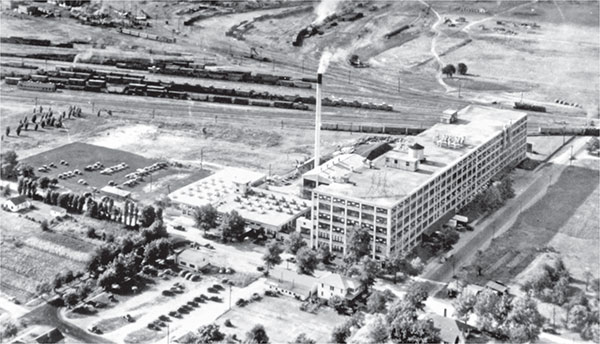
The Quaker Maid Company plant, a major employer from 1930 to 1979, produced food products under the Ann Page, Iona and Sultana labels. Courtesy J.S. Calvert Collection.
MARCH
MARCH 1
2002—South Vigo State Championship
Tension was running high; the Class 4A girls’ basketball state finals would be played at Conseco Fieldhouse the next day. The Terre Haute South Vigo High School basketball team, coached by Al Maroska, would face South Bend Riley in the state championship game. What a victory! Reicina Russell, Melanie Boeglin and their teammates went on to win 63–42. Up to now, Terre Haute had been the largest Indiana city to never have won a state basketball title, boys or girls.
The previous year, the South Braves had won its first team state championship since the school opened its doors in 1971. The girls’ tennis team, coached by Bill Blankenbaker and ending the season undefeated, went on to win the state championship over Anderson Highland. Kristen Clary, the number two singles player on the 2001 tennis champion team and starting guard on the girls’ basketball team, commented, “In both sports we knew we had a chance if we worked our hardest.”
MARCH 2
1961—Viking Mine Explosion
The Terre Haute Tribune reported, “Explosion at Viking Mine Kills 22. A violent explosion apparently killed the men in their tracks. Only one body could be recognized by his features. The other charred and mangled bodies were identified by their belt numbers. Two or three spotlights illuminated the scene, and some 200 persons stood in the cold seeing nothing and finding no words to speak.”
Shortly before dawn, relatives of the miners began arriving at the Bedino Chapel of the Valley Mortuary in West Terre Haute. Ambulances delivered bodies to the back doors as they were lifted out of the charred shaft of the Viking Mine. Gilbert Bedino turned his largest room over to the dead with bodies laid in two rows; wives and families walked between them. Dr. D.M. Ferguson, Vigo County coroner, said, “This is the most horrible sight I have ever seen.”
MARCH 3
1952—A&P and Quaker Maid
A “Salute to Terre Haute” was staged by A&P Food Stores and its subsidiary Quaker Maid plant on Fruitridge Avenue to celebrate the company’s more than fifty years of service in Terre Haute. As part of the event, women from the local Quaker Maid plant conducted olive demonstrations during this week in the newly remodeled stores at 1168 Lafayette Avenue, Eighth and Poplar Streets and 1612 Wabash Avenue. A&P was the nation’s largest supplier of processed olives, buying them through its offices in Seville, Spain. After the seeds were removed and replaced by rolls of red pimento, the olives were shipped in brine from Spain directly to the local plant. The brine was washed away and replaced with a fresh solution, the protruding pimento ends clipped and the olives place-packed by hand. Quaker Maid was shipping some three thousand cases of plain and stuffed olives from Terre Haute each day.

The Quaker Maid Company plant, a major employer from 1930 to 1979, produced food products under the Ann Page, Iona and Sultana labels. Courtesy J.S. Calvert Collection.
MARCH 4
1909—Motorcycles at Show
The 1909 model of the Harley-Davidson motorcycle was featured at Terre Haute’s first automobile show by William Jenney, a bicycle dealer located in the Grand Opera House Block. It was promoted for everyday use, as well as for touring, hill climbing and racing. Jenney faced competition from the Indian motorcycle displayed by J. Fred Probst with a dealership in the Rose Dispensary building. The Indian held every record from 1 mile to 100 miles and won 90 percent of all its contests. J.E. Sayre and Company, located at Fourth and Ohio Streets, was there, too, with the Excelsior Auto-Cycle and the Yale and Thor motorcycles. The Thor was the only survivor and perfect-scored machine in the 1908 Chicago Endurance Run and Elimination Trials. The five-and-a-half-day competition covered 1,110 miles through sand, mud and water.
MARCH 5
1936—City Directory
R.L. Polk and Company issued the largest City Directory to date. A total of 42,880 names were listed under Terre Haute and 2,360 in West Terre Haute and Taylorville. Privacy didn’t seem to be an issue. The listing for each adult resident included the name, address, marital status and occupation (employer or employee). It also indicated homeownership or a rental dwelling at each address. Samuel Beecher was the mayor, with 76 men on the police force and 116 in the fire department. Sixty-one churches served the area. The business section listed five banks and thirteen building and loan associations. Ninety-one gasoline and oil service stations were in business, as were more than 350 retail grocery stores; long before the “big box stores” arrived, small retail businesses ruled. The Oakley, Kroger, Piggly-Wiggly and A&P grocery chains, also in the city, were sure signs of the future.
MARCH 6
2004—Dining Out
Conversation among coffee drinkers at local eating places at times includes the question, “Just how many restaurants are there in our county?” The answer—209 restaurants—was cited in a Tribune-Star feature by Howard Greninger using a report of the Terre Haute Convention and Visitors Bureau of Vigo County. This total broke down into 98 sit-down restaurants, 69 fast-food restaurants, 26 pizza parlors and 16 coffee or sweet shops. “We are the big fish in the regional valley of small cities. The large chain restaurants are here simply because of the traffic numbers and those numbers are at Interstate 70 and U.S. 41,” said David Patterson, executive director of the bureau. Rod Crider, president of the Terre Haute Economic Development Corporation, added, “The restaurant industry is a strong part of the Vigo County economy, with Terre Haute restaurants averaging twenty employees and $400,000 in sales annually.”
MARCH 7
1883—Rose Polytechnic Institute
Rose Polytechnic Institute opened today in its building at North Thirteenth and Locust Streets with the induction of Charles O. Thompson as president. Twenty-five young men, chosen through a competitive examination, made up the first class. The building was open to the public to view and to learn about this new institution, which had been well endowed by Chauncey Rose. The Terre Haute Express commented, “Perhaps many people who have watched the rise of the building have an incomplete idea of what a polytechnic school is. It aims to do for engineers, mechanics and artisans generally, what the colleges have done for clergymen, lawyers and doctors.” The campus was moved east to its present location in 1922. “Rose Poly” became Rose-Hulman Institute of Technology in 1971.
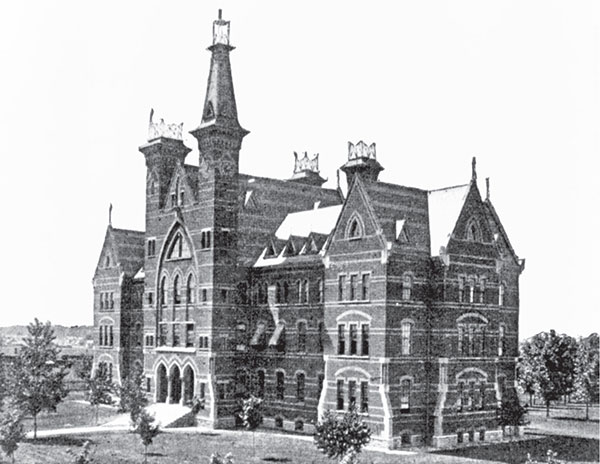
The building housed Gerstmeyer Technical High School, home of the Black Cats, from 1922 to 1971. Courtesy J.S. Calvert Collection.
MARCH 8
2005—New Penitentiary
The U.S. Penitentiary–Terre Haute, the 111th facility of the U.S. Bureau of Prisons, was dedicated on this day. The structure with 1,080 cells would be staffed by 745 employees under Warden Mark A. Bezy. “These people will spend money in the community, and it should have a significant impact on Terre Haute,” said Harley Lappin, director of the Bureau of Prisons. Judy Anderson, former Terre Haute mayor who had worked with community leaders nearly four years earlier to bring the prison to the city, recalled, “The first time we went to Washington, D.C., the Bureau of Prisons said we were the first community which came to thank them for having a facility in their community and the first community to ever ask to have a new one. We knew this was economic development.” This new facility, the older one in use since 1940 and the minimum-security camp make up a federal correctional complex on 1,145 acres.
MARCH 9
1874—Wagon Bridge
Tolls were no longer collected after the Vigo County commissioners paid $80,000 to the Terre Haute Draw Bridge Company for the “Main Street wagon bridge” at Wabash Avenue. It had been opened to traffic over the Wabash River in 1865, replacing the first wooden drawbridge in use since 1847 at the foot of Ohio Street. The sign on this double-wagon structure, as shown on a sketch by Professor E.W. Cowen, read, “Keep to the right. One dollar fine for riding or driving faster than a walk over the bridge.”
MARCH 10
1839—Prairie House
The Wabash Courier announced:
The subscriber (late of Baltimore, Maryland) respectfully informs the citizens of Terre Haute and the traveling public generally, that he has opened the large and extensive new hotel, recently built by Chauncey Rose, Esq., where he will be happy to accommodate travelers and permanent boarders…the subscriber will only add that neither pains nor expense, shall be spared, on his part to give general satisfaction. (signed) Theron Barnum.
The hotel was called “Rose’s Folly” by those who felt it was too far out of town. Rose closed it in 1841 and then reopened it in 1849, with T.C. Buntin as manager, as traffic began to increase. The hotel was renamed the Terre Haute House in 1855. The present Hilton Garden Inn is the fourth hotel to be constructed on this site, at the northeast corner of Seventh Street and Wabash Avenue.
MARCH 11
1927—“Terre Haute Once More”
According to the Elementary School Journal in March 1927:
The Board of Education of Terre Haute, Indiana, has once more availed itself of the legal right to sacrifice the interests of the school system to politics and personal interests. It has dismissed a competent superintendent [J.O. Engleman], who refused to appoint teachers in according with the behest of Klansmen elected by popular vote…To be sure the better people were clear in their recognition of Mr. Engleman’s services to the city. They made him president of the Rotary Club. They used him on all public occasions when dignity and integrity and service were demanded.
The president of the board of education responded to the Journal editors: “Our Dr. Engleman has been a very efficient, conscientious and painstaking superintendent, working entirely for the best interests of the schools, and the whole difficulty has been his refusal to make appointments which the majority of the board, who give every evidence of being tools of the Klan, recommended.”
MARCH 12
2013—Year of the River
More than seventy-five organizations and groups, planning a variety of related projects, were involved in the Year of the River, adding to the excitement of the ongoing Riverscape initiative. Mary Kramer of Arts Spaces Inc. remarked, “I don’t know if you’ve ever seen a river smile, but I think the Wabash River is smiling pretty fiercely now.” One of the interesting plans, announced this week, was a new outdoor mural to be painted downtown on the west wall of the Cox, Zwerner, Gambill and Sullivan Law Firm at 511 Wabash Avenue. It was to be undertaken by the Indiana State University Department of Art through the ongoing Gilbert Wilson Memorial Mural Project. Artists Michael Neary and Amy MacLennan planned to do the painting in the spring with help from ISU students.
MARCH 13
1825—Pork Packing
Mike McCormick, Vigo County historian, named Benjamin I. Gilman “Terre Haute’s father of commerce” based on the fact that Gilman opened a meatpacking plant at First and Mulberry Streets in 1824. The following year, the Western Register & Terre Haute Advertiser reported:
On the morning of the thirteenth, two boats belonging to Mr. Gilman deeply laden with pork left this place…It is not unusual to see boats laden with this article leave this place—but we venture to assert that such cargoes never before descended the Wabash…these cargoes are destined we understand for a more distant market, that of New Orleans. This commencement of a trade in one of the staple commodities of our country, bids fair to be of great utility…we hope that the liberality of Mr. Gilman will be met by corresponding conduct on the part of our agriculturalists.
MARCH 14
1913—State Song of Indiana
“On the Banks of the Wabash, Far Away,” was adopted by the Indiana General Assembly as the state song of Indiana. First published in 1897, the song was composed by Paul Dresser, a native of Terre Haute and older brother of novelist Theodore Dreiser. Paul was born in 1858 to Johann Paul, a German immigrant, and Sara (Schanab) Dreiser in a home not far from the Wabash River. Working as an entertainer, he changed his name from Dreiser to Dresser. His sentimental songs, such as “The Letter That Never Came,” made him the most popular Tin Pan Alley composer in New York City during the 1890s. He died in 1906 before his “My Gal Sal” became a national hit. He is buried at Saint Boniface Cemetery in Chicago, Illinois. The sculpture A Song for Indiana by Teresa Clark was dedicated by Arts Spaces Inc. at his birthplace in 2014.
MARCH 15
1987—Children’s Museum
The Children’s Science and Technology Museum set up a display at the annual Home Show in Hulman Center. It was a preview of the permanent museum to open in 1988 in the Central Christian Church, at 720 Larry Bird Avenue. In 1990, the museum moved into the former Terre Haute First National Bank building at 523 Wabash Avenue, its location until the new $5.6 million Terre Haute Children’s Museum at 727 Wabash Avenue was completed in 2010. John Thompson, board president, said, “It started off with three people, sixty dollars and a dream,” naming the founders Susie Schnabel, Bernard Ridens and Jerry Mansfield, all present for the dedication ceremony. Crowds in the thousands packed downtown on the opening days of the museum during the Sixth Annual Street Fair. Bill Nye, “The Science Guy,” and SpongeBob SquarePants made guest appearances. Lynn Hughes was the museum director.
MARCH 16
1940—Eleanor Roosevelt
Anna Bowles Wiley, reporter for the Terre Haute Tribune and Sunday Star, wrote, “Mrs. Eleanor Roosevelt (Mrs. Franklin D.) had ‘Her Day’ in Terre Haute.” Arriving at Union station, the first lady was driven to the Terre Haute House and to Indiana State Teachers College, which was dedicating the New Student Union Building and Auditorium and the Fine Arts and Commerce Building. Instead of lunch at the hotel as planned, she chose to share the meal with the forty boys at the National Youth Administration Experimental House on North Sixth Street. Her dedication address was presented in the auditorium of the Union Building, which had been constructed as a federal Works Project Administration project. Her subject was “The Problems of Youth.” She believed the worst problem of youth is their lack of employment, adding, “If you would foster democracy, you must give youth a chance to work.”
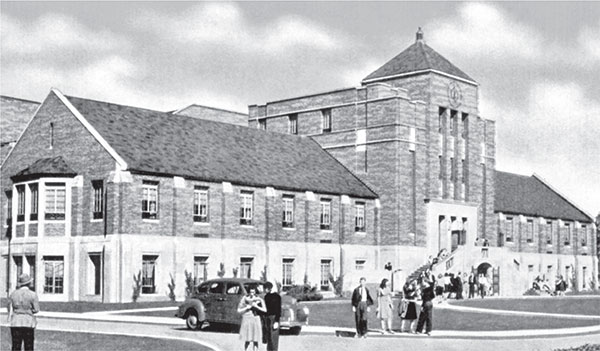
Now Tirey Hall on the Indiana State University campus, this building remains the home of Tilson Music Hall, a popular venue for concerts and programs. Courtesy J.S. Calvert Collection.
MARCH 17
1934—Champagne Velvet Returns
Saint Patrick’s Day was a special day to celebrate the reopening of the Terre Haute Brewing Company, closed since the Indiana prohibition amendment became law in 1918. The event promised to add millions to Terre Haute’s payroll and employment to hundreds of workers. Oscar Baur had returned to his native city in 1933 to rehabilitate and modernize the building at Ninth and Poplar Streets into what would become Indiana’s largest brewery. Thousands of visitors, often with their mayors representing Wabash Valley towns, made up a huge parade with many colorful floats. Bands played the new “Champagne Velvet March.” Plant officials served free beer to thousands of persons on the street in front of the serving room at Ninth and Oak Streets. Upon entering, each person was given tickets for four glasses of beer; when these were used, the recipient was expected to make way for others.
MARCH 18
1926—Claude Thornhill
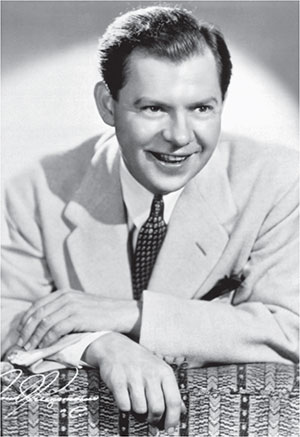
From age four, Thornhill was taught to play the piano by his mother, Maude Thornhill, church organist and choir director. Courtesy J.S. Calvert Collection.
Thornhill, a senior at Garfield High School, was attracting attention as the pianist with the Liberty Theater Orchestra. It is said his solos “stopped the show” with outbursts of applause from the audience. He had started working jobs at the age of twelve years, but the best was yet to come. He moved to New York in 1931 to play with big-name bands, and later he became a part of the Bob Hope Show on the radio. In 1939, he formed his own band, with Metronome magazine naming it “the best big band ever” in 1941. He enlisted in the U.S. Navy in 1942 and spent the war years entertaining troops in the South Pacific. Reorganizing his band after the war, he remained in demand with his “one-finger solos” and his theme song, “Snowfall.” He was scheduled to appear at the Steel Pier in Atlantic City when he suffered a fatal heart attack at age fifty-six.
MARCH 19
1963—Downtown Fire
For eight hours, a fire raged uncontrolled in the downtown, causing $5 to $6 million damage and injuring nine firemen and a civil defense auxiliary policeman. The blaze had started in the Campus Bowl, a bowling alley located in the basement of the Deming Building at 9 North Sixth Street. Whipped by very strong winds, fire destroyed four buildings along with ten prominent businesses and five offices located in them. Only smoldering ruins remained from the northeast corner of Sixth Street and Wabash Avenue to the alley north of Sixth Street and east on Wabash Avenue to the Meis store at Sixth and a Half Street. The Jame-Wolf store’s double fire wall had stopped the blaze from spreading even farther east. Fire chief Norman Fesler said, “Almost every roof in the downtown area would have been afire if members and volunteer units from neighboring areas of Vigo, Clay, Sullivan and Vermillion counties, and even the Indianapolis area, had not come to the rescue.”
MARCH 20
1960—Jewish Congregation Centennial
Members of Temple Israel and Temple B’nai Abraham celebrated the centennial year of formal Jewish congregation life in Terre Haute at a dinner and dance at the Hotel Deming. Although Jewish settlers had lived here since the 1820s, a formal congregation was not established until 1860. The congregation of Temple Israel built its temple at 540 South Sixth Street in 1911. The Temple B’nai Abraham building was constructed at Fifth and Poplar Streets in 1926. Temple Israel, a Reform congregation, and B’nai Abraham, an Orthodox congregation, merged in 1935 to become the United Hebrew Congregation. It kept two buildings, two rabbis and two sets of services for twenty-five years. In 1965, Ben Blumberg bought the Fifth and Poplar building, and it became the Wabash Valley Senior Citizens Center. Religious items were moved to the synagogue on Sixth Street, which continues to be the home of the United Hebrew Congregation.
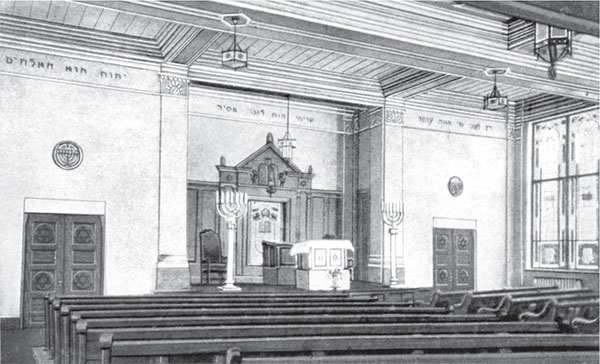
Temple B’nai Abraham sanctuary, circa 1930. Courtesy J.S. Calvert Collection.
MARCH 21
1942—Swope Art Gallery
“History was indeed in the making” as a large crowd formed a constant stream through the six exhibition rooms at the official opening of the Swope Art Gallery. It was thirteen years after Sheldon Swope died that his dream was brought to realization by his generosity and by John Rogers Cox, director, and William Turman, Mrs. Walker Schell and Omer Rhodes as the board of managers. The collection already included the works of masters Edward Hopper, Grant Wood and Thomas Benton. Blanche Bruce, Terre Haute artist, wrote, “Feasting our eyes on the collection and…wondering all the while if it is really true, are you really in Terre Haute?” An active alliance was founded in 1952 to promote the exhibition program. Located in the Swope Block building at Seventh and Ohio Streets, this local treasure was renamed the Sheldon Swope Art Museum in 1988.
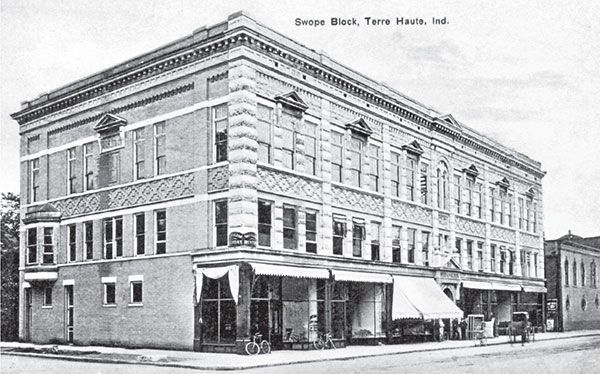
The Swope Block, completed in 1902, housed a number of professional offices by 1910. The Wabash Business College and Maccabee Hall were located on the third floor. Courtesy J.S. Calvert Collection.
MARCH 22
1947—Purple Eagles
The Garfield High School Purple Eagles were in Indianapolis to compete in Indiana’s annual High School Basketball Championship. Garfield, arriving with a thirty-game undefeated record, won over Marion to enter the state championship game. Almost fifteen thousand fans were at Butler Field House to watch Garfield and Shelbyville play for the title. Bob Nesbit, Terre Haute Tribune sports editor, wrote, “The jinx that has defied all unbeaten contenders in the thirty-seven-year-old history of the Indiana state basketball derby once again thwarted all challenges tonight as Shelbyville’s Golden Bears captured the Hoosier Championship by handing Garfield a 68–58 setback in the final game.” Clyde Lovellette was the top scorer, and Ronnie Bland was awarded the Arthur L. Treaster sportsmanship medal. A gigantic parade stopped downtown for a short pep session and ended at the school, where hundreds of fans jammed the gym to pay tribute to Coach Willard Kehrt and his team.
MARCH 23
1913—Easter Tornado
“A tornado, beginning at 10 o’clock on Easter night, laid waste to several hundred homes, claimed the lives of seventeen persons, resulted in severe injury to more than 150 persons whose names are not known…and caused property damage estimated at between $1,500,000 and $2,000,000.” This report issued by the Terre Haute Publishing Company continued, “Beginning a few miles north of Prairieton, it traveled in a northeasterly direction, leaving a trail of death and damage in a path four blocks wide…Homes were crushed as though they were made of paper.” Physicians and Sisters of Mercy at Saint Anthony Hospital placed the injured in all available rooms and on the floors of the corridors. Relief stations were set up at the Fairbanks and Greenwood elementary schools. It long had been believed that the bluffs on each side of the river deflected such severe storms, but the city had been struck by tornadoes before and would be again in 1949.
MARCH 24
1913—Easter Week Flood
Following the tornado on Easter Sunday, a flood devastated Sugar Creek Township, as well as parts of Terre Haute. On Monday, thirty-five Toad Hop families and twelve West Terre Haute families left their homes. On Tuesday, part of the National Road was closed. On Wednesday, half of West Terre Haute’s residents were homeless and area mines were closed. Only pedestrian traffic was allowed on the Wabash River bridge. On Thursday, water was over the Macksville grade, 2.00 feet deep on Paris Avenue. By noon, the river was at 31.03 feet. On Friday, two hundred people were stranded at Whitcomb Heights and Ferguson Hill. Finally, the Wabash River began to fall a half inch per hour, and cleanup and rebuilding began. This disaster was recorded by the Terre Haute Publishing Company in a paperback entitled Terre Haute’s Tornado and Flood Disaster.
MARCH 25
1935—Virginia Ellis Jenckes
According to the Independent Feminist Weekly, “Virginia Jenckes was elected solely on her own merits and therefore occupies an enviable position in Congress as an independent Democrat.” Local Democrats had asked her, at age fifty-five, to run for Congress on the platform to repeal Prohibition in 1932. She was elected—the first woman elected to Congress from Indiana—and served three terms. Jenckes advocated flood control and opposed the Volstead Act on economic terms. Once Prohibition had taken effect, there was no work for the brewery and distillery workers, and farmers saw the corn price drop from $1.45 to $0.10 per bushel. She also worked hard on behalf of the many Public Works Administration projects in her district. She remained in Washington, D.C., where she was involved with the Red Cross and Hungarian Freedom Fighters and served as a lobbyist for Catholics in public affairs.
MARCH 26
1900—Country Club
The City Directory lists the incorporation of the Country Club of Terre Haute with capital of $2,500, Jay H. Keyes as president and H.J. Baker as secretary. The address, “Wabash Avenue, east of Highland Lawn Cemetery,” identifies the fifty-six acres acquired from Ray G. Jenckes to establish a golf course. The nine-hole course opened in July 1900 and the clubhouse in October. The club purchased property adjacent to Allendale in 1918 from the Ijams family, and by 1922, the members had moved to its larger, present location. A clubhouse, completed in 1920, was almost totally destroyed by fire in 1923. A new clubhouse was completed in 1924–25, and nine more holes were added. The first course on East Wabash Avenue was purchased by the Phoenix Club, the local Jewish organization. Closed in 1979, the golf course is now the site of the Phoenix Hills estates.
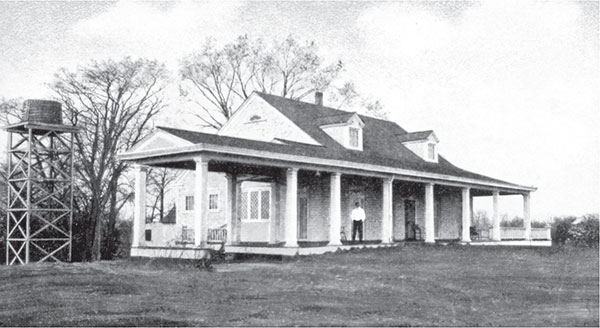
The clubhouse east of the city appears on this postcard, dated 1908 and mailed with a one-cent stamp. Courtesy J.S. Calvert Collection.
MARCH 27
1954—Saxton Mine
The Terre Haute Tribune read, “The Saxton Mine was to close on March 31 after being in operation since 1922.” Located north of the city on North Thirteenth Street Road, it was the oldest shaft mine in operation in Indiana. The Viking Coal Corporation said the closing was due to the fact that all mineable coal had been removed. Saxton had first been developed by the Grasselli Chemical Company to furnish fuel for its nearby smelting plant. After E.I. du Pont De Nemours purchased the Grasselli holdings in 1930, the smelting plant was shut down and coal was sold through Walter Bledsoe and Company. Up until this year, the 293 employed men had been producing three thousand tons of coal per day. Three other large mines also had closed down in recent years: Blackhawk in 1951, Wabash in 1952 and Dresser in 1953.
MARCH 28
1953—Lewis Explosion
“Half of the town of Lewis (Pierson Township), twenty miles southeast of Terre Haute, was leveled about 8 o’clock Saturday night by a series of explosions which followed derailment of an ammunition train,” reported the Terre Haute Tribune and Sunday Star. “The entire north part of town burst into flames within a matter of seconds and fire equipment was sent from surrounding communities. Bound for the Crane Naval Depot, twenty miles east of Bedford, the train was on the Chicago, Milwaukee, St. Paul & Pacific railroad carrying ammunition to be stored.” There were no fatalities, but several people were injured, nine houses and six stores burned and twenty-five boxcars and coal hoppers destroyed. Paul Morse, who was the first at the scene, is remembered as the “Paul Revere of Lewis.” Dessie Welch, a seventy-one-year-old telephone switchboard operator, was the heroine, staying at her post in a badly damaged building to notify emergency personnel. She later was featured in a Saturday Evening Post article, “Operator, This Is an Emergency.”
MARCH 29
1865—Medal of Honor
“Herewith I enclose the Medal of Honor, which has been awarded you by the Secretary of War under the Resolution of Congress,” read the letter to P.J. Ryan of Terre Haute from the Adjutant General’s Office, War Department. Ryan’s story was told as follows: “During the engagement at Winchester, September 19, 1864, he donned a Confederate uniform and got mixed with some Confederate stragglers. Finding himself with thirteen of them, he said, ‘Boys, let’s give them another volley.’ The ‘Rebs’ fired and then revealing himself to them, he marched them to Union headquarters as prisoners of war.” For this act of bravery in action, he was awarded the Congressional Medal of Honor, the first Indiana soldier to receive this honor. He returned to Terre Haute and engaged in business as a harness dealer and then as a funeral director. P.J. Ryan and Sons Funeral Home was incorporated in 1908, the year of his death.
MARCH 30
1958—Terre Haute Drive-In
The Terre Haute Drive-In Theatre celebrated its eleventh anniversary. Each patron attending that Sunday evening received a free orange drink and popcorn, and each lady was given a Swiss crystal candy dish. The double feature included the Korean War story Time Limit with Richard Widmark and The Deerslayers. Located at 2545 North Lafayette Avenue, it was one of the first drive-in theaters in the state and one of the first to install a Cinemascope screen and magnetic stereophone sound. Projectionists were members of Motion Picture Operators, Local 373. During the winter of 1957–58, the theater was open each weekend, making it the first drive-in to remain open year-round in the area. Special highlights included seven hundred speakers, seats on the patio for walk-in patrons, “smoke if you like,” free admission for children under twelve years, a free baby bottle warmer and a large, free kiddie land. Keith Lee was the local manager.
MARCH 31
1818—County Seat
An advertisement in the Vincennes Western Sun called for the construction of a courthouse “of brick and 55 feet square” to be built in Vigo County. Earlier in the year, Vigo County had been formed by an act of the legislature at the first state capitol in Corydon. Two months later, the commissioners, appointed for that purpose, selected Terre Haute as the seat of justice for Vigo County. William B. Pickett, Rose-Hulman Institute of Technology historian, explained, “Terre Haute became the county seat through the deliberate efforts of its founders. The Terre Haute Land Company had provided for a public square in its town plan, so in 1818, when the first county commissioners were appointed, the company directors offered a bonus of $4,000 to the commissioners as an incentive to put the county courthouse there. The tactic worked.”